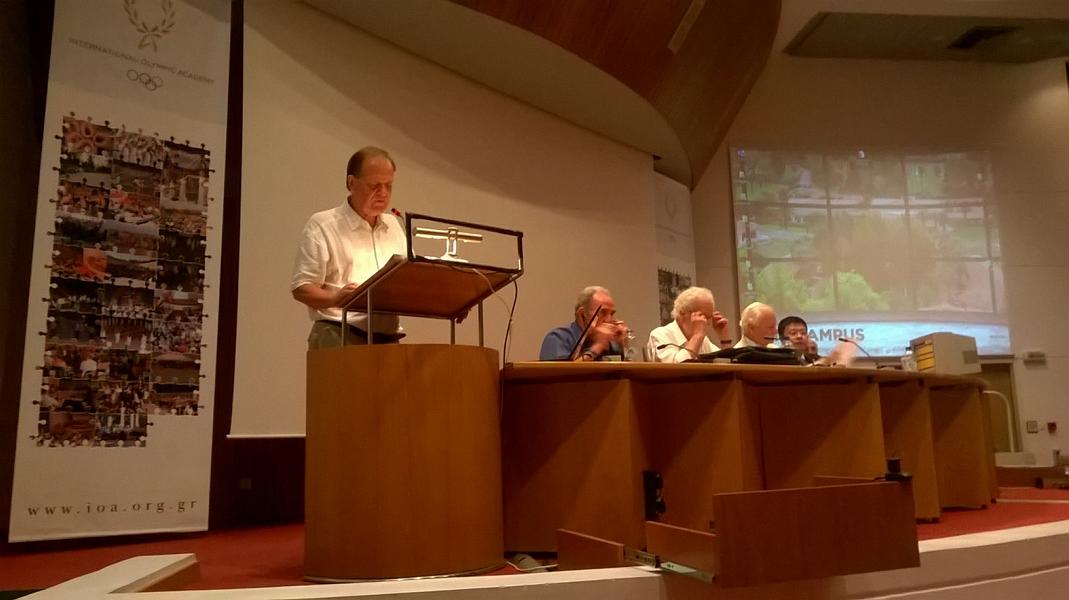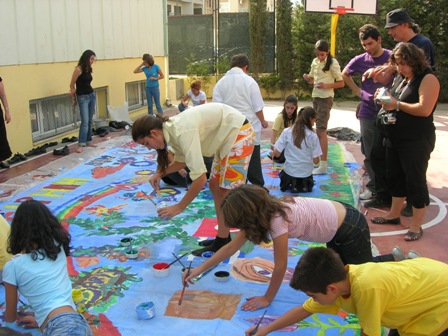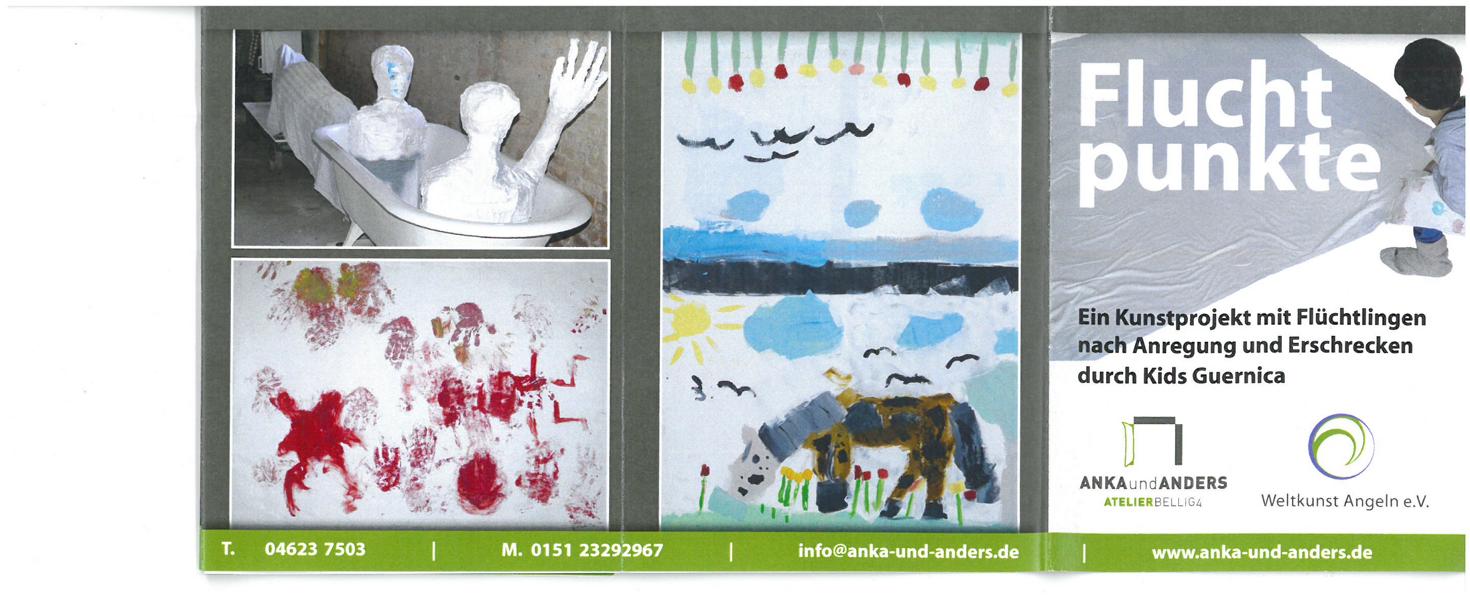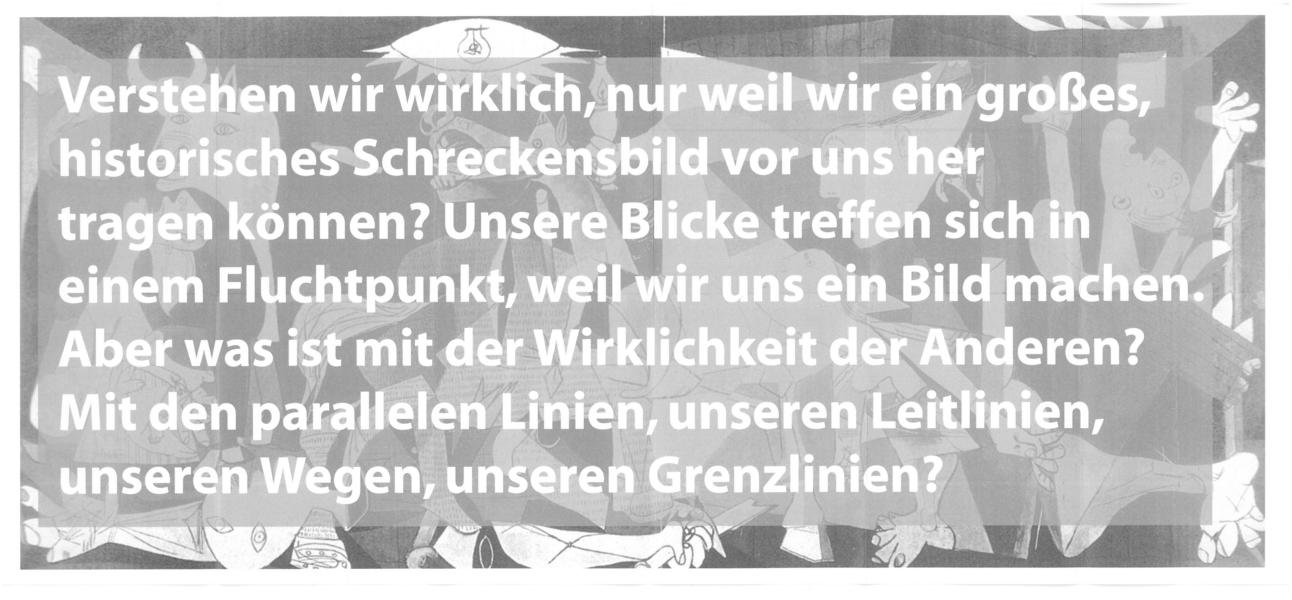Presentation by Hatto Fischer
Hatto Fischer - Presentation at the Symposium "The need of a constructive dialogue", 1 -7 Sept. 2015
1. Poiein kai Prattein

Poiein kai Prattein means 'create and do.' That requires some explanation.
When Adorno and Horkheimer published 'Dialectic of Enlightenment' in 1944, they wished to explain the failure of the Enlightenment especially in view of 'crimes against humanity' committed by Nazi Germany. In so doing, they stated that even when Fascism has been defeated, there will be still active Xenophobic forces ready to undermine efforts to govern free of fear of the other. One plausible explanation they gave was the huge discrepancy between those who do all the hard work while other parts of society dwell in luxury and complete ignorance as to the fate of their fellow men. Interestingly enough, the two philosophers traced that fateful division back to Ancient Times when the separation between work and pleasure was already a key feature of how society was organised in those times. Homer narrates that Odyssey could hear the song of the Sirens but was unable to follow their treacherous lure due to being fastened to the mast, while his crew could not hear his command to undo the ropes as they had wax in their ears. Hence they rowed on and did their work without having the pleasure of hearing the songs of the sirens. That division is fateful since work without pleasure or vice versa only pursuit of the arts for pleasure leave all problems of society and politics outside any realm of human self-understanding. This is critical for any effort aiming to bring about a constructive dialogue since this division has to be overcome.
Due to this seperation of work and the arts, human self consciousness is difficult, if not impossible to attain. If that is the case, then the search for conditions which would foster a constructive dialogue, and therefore what this Symposium seeks to reflect upon, is burdened already by the prospect of attempting the impossible. In reality, it is about the search for such a language which overcomes such division of labour. Required is a language in which the human voice can be heard, or to put it in another way, man or woman is not forced out of fear to mask own motives and thoughts especially when caught within a hierarchical order and speaking with someone placed up higher in the ladder of authority. This problem of people ending up using a slave language (Ernst Bloch defined it as perverting all meanings so that a curse means praise and vice versa a praise a curse) is that they fail to dignify themselves as 'human beings' when speaking to others.
So while everything from poetry to music seeks to carry the human voice to the surface, so as to constitute human self consciousness as prime basis of all social interactions, too many turn never realize the importance of this. Rather they turn around out of fear to be vulernable if too open and hence they tend to disappear behind cliches and a common language which allows conversation without being a dialogue e.g. when exchanging merely what the weather will be like today or saying "everything is fine" when it is not. Rather they terminate a deepening of the conversation before they could be grasped in their humaness or lack thereof.
What seems to prevent a critical reflection thereof is not only the practice of the so-called Master language deploying sophisticated terms to mask the real lack of knowledge, and which Socrates tried to expose through his understanding of dialogue as a mode of questioning until the other has to admit he does not know. There is also a strong tendency to divert attention from this issue by polarising the world view into fake alternatives as if the construction of reality would not make a difference between doing it for a purpose or just for the sake of upholding an absolute spirit or concept like God to safeguard the unity and therefore the methods by which others are silenced if they would dare to oppose this construction of reality. Interestingly enough this alternative becomes in Greek Idealism a spin off from a realistic assumption as to the nature of man since like the Gods he is capable of cheating and lying, but also equally able to achieve something better than all others, and therefore stand out like the Olympic winner. No wonder when the latter is then celebrated as if a semi God, but better achievement means nothing shall be done to achieve a betterment of humanity. This is remarkable since it safeguards the ideological positions taken up by pragmatist and realists alike since they assume things can be achieved independent from the need to have to change first man before any improvement in the economy and in politics can be guaranteed.
As a result of this disillusionment reinforced by Idealism many end up speaking in a masked manner. That is especially the case of the slave language (see treatment thereof - in German - by Ernst Bloch und die Sklavensprache (Berlin 1985)/ Slave language (Cornell U. 1987)). As said already above, that language is spoken not only by slaves, but by those who stay within a hierarchical order. It means whenever they speak to someone placed higher up in the hierarchy, they mask their real motives and emotional selves while succumbing to the fear of authority.
If living conditions of people are to improve, equality and human dignity need to prevail. Both are attained through dialogue based on the freedom to give recognition to others not only as human beings, but on how they fit into society in a substantial way. Hence it does matter what language all use, or rather in which language they address each others, and this in recognition of real needs. If the other is merely treated as an object, Kant's dictum of no human being should be used as a means for another purpose, but be an end to itself, would be violated. Likewise the use of a command language as the case in the military degrades the other to the point of having to obey merely orders. Any such one sided approach degrades and alienates the self and does not allow that the human being articulates itself.
Marx observed if emancipation is to occur, then such a language is needed which touches upon theed human self consciousness. In order to be able to that, he stated that both categories of productivity and of creativity have to be brought together. By forming such a language, it makes possible human dialogue.
Furthermore, it should be recalled that Aristotles ended up understanding that "lessons of categories" refer to the language in use, and this in terms of a grammar of life. He was, therefore, most observant on how language was being used in a logical way so as to reveal reason and meaning of the terms being used to designate or rather categorize something. This grammar is what makes speech in a logical and coherent way possible. In so doing, he draws lessons from matter - the materials of life. As this involves sense perception, he needs to reflect at the same time what guides us to do the right actions? That practice of reflection through dialogue is really 'theory'. If man is in need to know to which ends to strive for, Aristotle recommends that it is wise to link up with one's own imagination which allows seeing into this reflective process, or else to go to that man who is rich in imagination, and therefore capable to foresee the consequences of the actions on is about to undertake as he takes into consideration what else can happen in future. Hence the wise thing to do depends upon entering a dialogue of the self with the imagination so as to be able to cross over from doing to reflecting as to what can be done as well in future, and for which conditions have to be created first before being able to act accordingly.
In modern times, this has become more precarious than ever. The theory-practice reflection out of already made experiences is no longer constitute through dialogue. Already terms like 'discourse', but also rhetoric and argumentation indicate a displacement of dialogue has taken place. No wonder then, when human self-understanding is anything but self-understood (Adorno).
At the same time, scant attention is being given to the arts, even though human self consciousness depends as much upon poetry and philosophy as on a framework of references so as to ensure these self critical reflections. The latter depend or rather derive their strength out of real opportunitie to experience productivity. The latter is what makes and keeps the community of mankind alive and able to survive. That it requires democracy was self-understood in Ancient Greece, in particular during the times of Pericles who said not an army but active citizenship is the best form of protecting a city. Unfortunately that is not the case nowadays. If only politics could be realized through constructive dialogue. Only then can be brought about a common life in freedom.
The knowledge of how to make possible living and working together in freedom depends upon lived through experiences. It is what gives to every individual a voice so as to enable a common understanding of the meaning of words. Such human communication includes mediation. For most needed is the ability to resolve conflicts which are most often due to differences of opinions, interests and possibilities. Altogether they form a cultural synthesis in the making so that it is possible to probe through dialogue the possible relationships between the parts and the whole.
For culture and democracy to be constituted by dialogue, it means not to exist merely as individuals, but as active and engaged members of the community. Within that spectrum of coincidence and integration of the self in some lawfulness of life, the unfolding nature of creativity and productivity requires good questions are posed. By bringing these categories together in a humane language, the cultural synthesis shall be reflective out of the multiplicity of dialogues making possible the extension of poetic expressions into philosophical reflections. For dialogue is the best way to stay in touch with reality. Hence a NGO like Poiein kai Prattein can provide orientation by ensuring that the intuitive knowledge of poets is validated by philosophers, urban planners, architects and others when it comes to improving living conditions in cities and other localities outside the urban realm.
2. A brief history of Poiein kai Prattein: Poets and the reality of Olympic Games - in search of an Olympic Truce which holds
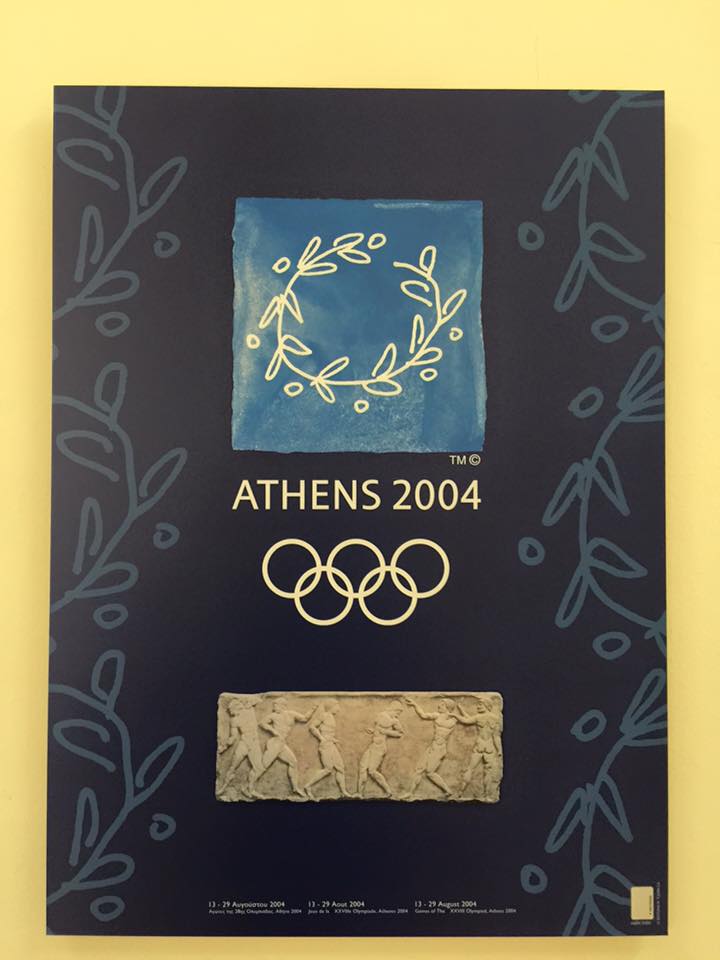
When the Olympic Games were held in Athens 2004, Poiein kai Prattein published ten books of poetry to connect poets to the quest that the Olympic Truce shall be upheld during the Games.

Sam Hamill
It includes poets like Sam Hamill - Poets against the War. As founder of "Poets against War" in the United States, he dealt with a country already deeply engulfed in war due President Bush following the principle of 'permanent war' (Rumsfeld doctrine) first in Afghanistan and then since March 2003 in Iraq.
The collection of poems on this subject includes the 'war diary' by Katerina Anghelaki Rooke while other poets reflect as to what has become of Bagdhad. The city was attacked in March 2003 first from the air for two weeks, before USA ground troops and other coalition forces moved in to dispose of Saddam Hussein. A huge disappointment was that Havel, the President elect in the Czech Republic after he had come to power thanks to the velvet revolution, had signed a letter in support of this invasion. It proved to be disasterous war as can be seen in retrospect.
In writing this recapitulation in 2015, it can seen that not only an entire region in the Middle East is in turmoil, but everywhere civil war has broken out. That civil war is best described by the writer Enzensberger.
What shocked the youth back then was the hypocritical attitude displayed by all officials who had come out in support of the Games in Athens 2004. The American Embassy issued a press declaration stating as much as if the Olympic Games can take place while war rages on elsewhere like a wild fire. Alone this attitude towards the Olympic Truce, basically a disavowment of the true spirit, has led to a tremendous discreditation of the Olympic Games.
The Games in Athens were accompanied by not only waste of much money being spend on not accountable matters such as expensive apartments in New York as part of the Public Relations campaign, but there was the scandal with SIEMENS. The German company with headquarters in Munich was supposed to install an anti terrorist security system for a huge amount of money, but which never worked in the end. People were relieved that no such attack had taken place during the holding of the Olympic Games.
Another evidence of the failed staging of the Games was not only the huge debt left in its wake, and which was going to haunt Greece starting in 2009 when the size of the state debt was slowly revealed, but also the many unused Olympic venues standing around to create another kind of wasteland.
One wonders, therefore, when Thanos Skouras relativizes the problem, as if it is in human nature to lie and to cheat, while still striving for the ideal perfection of body and mind. He believes the following:
"The age of Hermes should be completed but it needs also to be corrected. It must not be forgotten that Hermes is not without defects; stealing, deception and lying are part of his nature. Similar defects may characterize all the social constructs (that is, Olympic Games, market society, democracy, globalization), which are associated with him. Let us quickly consider them in turn. The obvious defect plaguing the Olympic Games is deception and the stealing of victory through the sophisticated use of doping." (Source: The age of Hermes: Reflections on the conceptual affinities of the Olympic Games, the market society, democracy and globalization - Thanos Skouras)
He then continues to argue in a footnote, that those who criticize the Olympic Games doing it out of a position of cultural elitism:
Footnote 12:
"The accusation (often heard in Greece) that they have degenerated into a commercial event dominated by big business misses the mark. The scale of an event watched throughout the world by billions (more than half of humanity watched the last Olympics in London) necessitates a high cost and is inevitably a big business affair. But it is the only truly global event that unites humanity in a celebration of human abilities demonstrated in peaceful competition. This inestimable achievement in the service of understanding and peace of humanity must be appealing to the mass of humanity and be based on a realistic rather than idealized view of man’s nature. Cultural elitism (which underlies the above accusation), whatever its merits, is certainly incapable of having a comparable appeal to the mass of humanity."
Such an argumentation is a direct distortion of the criticism articulated and more so disappointment felt by the youth of today. They have nothing to do with cultural elitism. Nor is the scandal of the Olympic Games merely doping, although the way an athlete can cheat himself into victory has a lot to do with what the Games have become, namely a big business and global enterprise deploying methods of deception. The propaganda used to illuminated upon the Olympic Gold medallist deserving unbelievable glory has become a commercial by-product of sponsors who love only the winner. And he must win consecutively like Bolt for the 100 and 200 m sprints to be sponsored. In other words, the hero must become predicable in an unpredictable way to achieve such massive financial support. What it can do to the individual may be reflected on hand of the tragic turn of South African rodeblade runner who ending up standing trial for having allegedly killed his girlfriend.
Even though the Olympic spirit can affect people, the fact that it is no longer amateur athletes but professional ones which participate, that renders any competition as being more than useless. Rather it reinforces exactly the wrong models of success but serves the purpose of a system depriving mankind of the human experiences needed while upholding fake measures of success. The Olympic Games are no longer a test of strength for those who fulfil still other jobs in society rather than making a career out of sport, and this in the spirit of international friendship. Rather each and every nation counts only how many medals it can win. To all of this a lot of marketing is attached due to the sponsorship involved in the Games.
Often one wonders, if the product is not more important than the participation of the athletes. One thinks of Coca-Cola or Nike for sport shoes, and everything else is blended out. Also in terms of the media coverage from a national vantage point, it seems as if only medals count. The Olympic Games do not overcome Nationalism. On the contrary, they revive Nationalism of all kinds and on all fronts. Thus a crisis breaks out in a national camp, if its athletes do not win sufficient medals. The crisis can be explained since then no politician can justify the money spend on the training of the athletes. It is sufficient proof that mere participation is not enough. Each nation wishes to demonstrate not merely to the world but to its own population that it is most successful. It counts as a magic like indicator for economic strength to which all politicians attach a great deal of importance, whether or not it means again an elite finds entertainment during the Olympic Games and the global business can unfold in accordance with preserving national interests. It resonates even with viewpoints in praise of competition as prerequisite for a free market to function, when in fact the Games are anything but free and fair competitions when lucrative contracts are awarded.
Definitely the statements made by Thanos Skouras should have been discussed at the Symposium "The need of a constructive dialogue", 1 -7 Sept. 2015, and this in the light of how the Games have evolved since 2004. One of his claims is that the Olympic Games in London was a huge success as a global business since it was able to unite humanity in a peaceful demonstration of competition. And yet Tony Blair in the UK had endorsed together with President Bush of the USA the invasion of Irak, in order to oust Saddam Hussein. A tone was set already in London when bombs exploded in the Tube and in one double decker bus in 2005 to create street fear. Since then the political line of thought has been British defiance as practiced during Second World War, and not an embracement of multi culturalism as characteristic of London of today, and which had won the bid for London on the basis of this special cultural feature.
Crucial for the discussion about dialogue is as well the essay 'Poetry and Violence by Brendan Kennelly', namely that poetry rarely faces violence and if so, it ends up easily glorifying violence rather than questioning its use. Since very often violence erupts there, where no dialogue seems anymore possible, it becomes a matter of how to question use of violence before it is too late. Indicative for this urgency is a call by Michel Foucault, when he says that "we have to discover the places of silence before the lyrical protest covers them up!" It means dialogues do not take place where and when people have been silenced, an those using power do not allow themselves to be questioned anymore. Police repression of demonstrators is but one side of the same coin when soldiers conduct a war in a foreign country even though the world is against war.
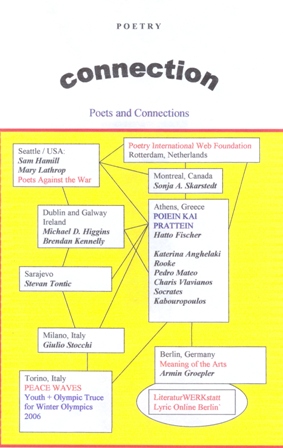
The ten books of Poetry Connection:
Poetry Connections
Poets and Olympic Truce
From Baghdad to Athens
Fear of Violence
Entries into the War Diary
Painting in Words - Pictures of War
Through Day and Night
Tramway or Streetcar poetry
Lonely in Victory
The Poem - a nose ahead although written in dust
As said already Athens 2004 was a huge disappointment especially for the youth. They witnessed that the Olympic truce was not being kept at all, and this mainly due to the war in Iraq and Afghanistan, but also because of all the corruption which accompanied the construction of the Olympic venues and the holding of the Games for only two weeks in Athens during August 2004.. That disappointment was deeply felt by the youth, and prompted Poiein kai Prattein to search for some solutions and new collaborators interested in upholding peace by bringing about a truthful Olympic Truce Resolution respected by all when the Games are being held.
3. Peace Waves and Poiein kai Prattein - preparing for the Winter Olympic Games in Torino 2006 and the Olympic Truce Resolution of the Youth
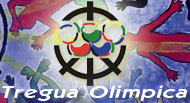
Hatto Fischer of Poiein kai Prattein came across PEACE WAVES, an organisation in Torino, Italy, during a conference held in Berlin 2004. Once contact was made, collaborative work was taken up. Finally, the Council of Europe supported a youth meeting held in and outside of Torino in February 2005 to bring about a new Resolution formulated by the youth.
The main aim of the youth was to prepare themselves already in 2005 to monitor the Winter Olympic Games 2006. They wished to see if the Olympic Truce would then be upheld and thought by organising a youth camp while the Winter Games were being held, this would be possible. For the purpose of monitoring, they formulated a new Olympic Truce Resolution. It was passed on to the Italian Parliament and from there to the United Nations. Unfortunately the youth camp was not realized during the Winter Olympic Games.
Two important points stand out in that OLYMPIC TRUCE RESOLUTION:
i. Olympic Truce: a challenge for sport... an opportunity for peace. The Olympic Truce meant in Ancient Greece “Ekecheiria” (“rising the hands”), used since 800 BC, after the drafting of a peace treaty, sealed by 3 kings (Ifito, Cleostene and Licurgo).
ii. A new Olympic Truce means not only a STOP to all the conflict during the Games, but peace from below has to be based on dialogues that were erroneously considered closed or impossible.
While that youth meeting was being held high up in the mountains above Torino, Hatto Fischer went down to the basement one day and came upon a group of youngsters all from different countries, including two young boys from Afghanistan, but also an Israeli girl who had already experience in the military, and a Palestinian boy by the name of Jad Salman. He would become later a close associate of Hatto Fischer as if an adopted son. The interesting aspect of it all was that they were not painting on a mere ordinary surface but rather the canvas had the same size as Picasso's Guernica, namely 7,8 x 3,5 m. This was the first encounter with Kids' Guernica which had been founded in Japan in 1995, and this in memory of not only Guernica which was bombed in 1937, but as well of Nagasaki and Hiroshima due to both cities having been destroyed by the first nuclear bombs ever dropped on humanity and therefore on innocent civilians.
All that left such a deep impression upon Hatto Fischer and Thomas Economacos, that they decided to take up communication with Kids' Guernica in Japan. Once contact was established, and Takuya Kaneda in Japan issueing an invitation to attend the 10th anniversary of Kids' Guernica in Ubud, Bali, it was decided to let children paint a peace mural in Athens and to send a delegation of Poiein kai Prattein to Ubud, Bali.
At the same time, Frederique Chabaud, then the coordinator of EFAH in Brussels, informed Hatto Fischer of Picasso's atelier where he had painted Guernica was restored and now under the guidance of Alain Casabona open to suggestions for further going projects, projects which would focus especially on creating conditions for dialogue between Israelis and Paletinians.
4. Message of the first mural of Poiein kai Prattein (2005): The war is over!
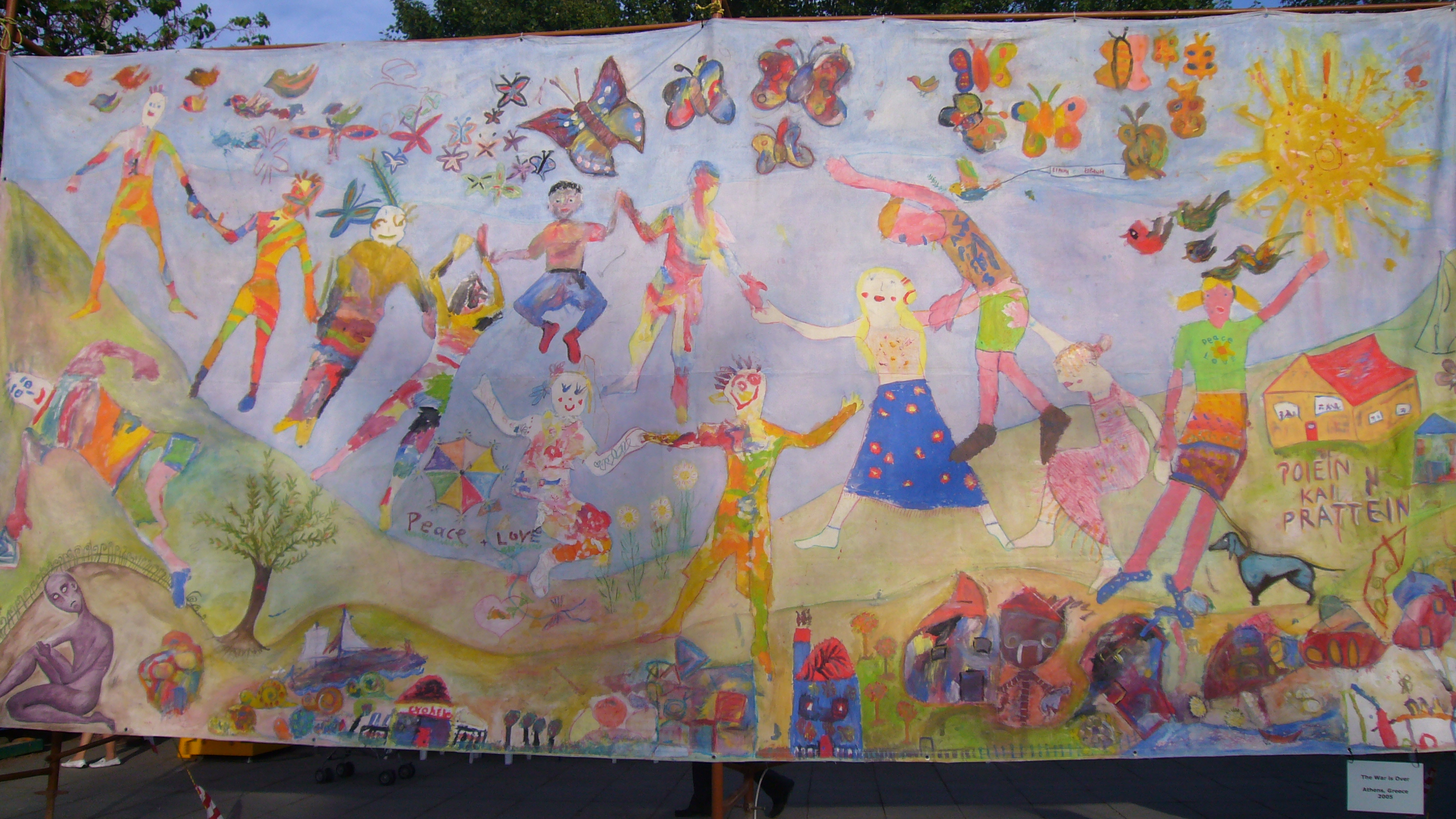
When children huddle together to deliberate about something challenging their outlook on life, then they enter a dialogue. It would be interested to observe more closely a unique complexity unfolding. The dialogue children practice contains not merely questions and answers, but they are as much puzzled or perplexed, as they will listen and probe any suggestion on how to resolve the problem they face altogether. Being challenged in a world view means exactly that, namely an acknowledgement that their world view is not perfect, consistent and the whole truth. That can lead to quite deep disturbances for then the value premises on which their view has been set, are in need to be re-examined, indeed be questioned. It is like perceiving the world as if flat and ending on the other side of the forest but once gone through such a forest and seeing open fields extending far beyond to where the eyes can see, it may be a first realization that the earth is not flat but round. Like humanity having gone through a tremendous learning process, so children reanimate first simple perceptions, if only having to learn that their assumptions need to be revised. As in politics revisionism is often scorned at as if a betrayal of original values, this questioning of own assumptions and presumptions means becoming a stranger to oneself as identity of oneself is intrinsically linked to some constant. It may be the hand of the mother often gripped when walking down the street.
Now in this case, there appeared suddenly in the left corner of the mural this sad figure. The girl who painted it was older than the rest. She was 16 at the time while the others were seven to nine years of age. Through the dialogue they engaged in, there emerged a solution. They decided to paint a figure floating down. The figure holds in the hand a letter containing the message: "the war is over!" Obviously they thought sadness equates with war while happiness with peace.
There has to be added the presence of Thomas Economacos who knows how to work with children in such a way that they are free to express themselves, and still have some guidelines given to them through suggestions often put to them in the form of questions e.g. would you think of sending a message to that sad figure? Whether or not he made such a suggestion is not known, but his presence did give the children huddling together to deliberate some reassurance that they will be on the right track.
5. Kids' Guernica in Japan 1995 - 2005
Poiein kai Prattein joined the 10th ANNIVERSARY EXHIBITION of KIDS' GUERNICA in Ubud, Bali, Indonesia August 18-20, 2005 by exhibiting among the many others the mural "The War is over".
As a result, a connection was established with Kids' Guernica and especially with its coordinator, Takuya Kaneda in Japan. It started in 1995 in reminder of the atomic blasts in Nagasaki and Hiroshima 1945. Further connections were made with similar actions in Nepal, India, and as it turned out a well Afghanistan.
Thomas Economacos and Maya Fischer as members of the delegation of Poiein kai Prattein returned with a request from Japan's Kids' Guernica for exhibitions in Greece.
After 2011 it was decided not to collaborate any longer with Takuya Kaneda and Kids' Guernica in Japan after several issues were not handled well or at all. Due to this the mainly European branch started to call itself Kids' Guernica - Guernica Youth.
In 2015, Kids' Guernica in Japan celebrated its 20th anniversary once more in Ubud, Bali. One artist who had participated in the 2007 exhibition in Athens after she had done a mural in Martinique, Savina Tarsitano, was present in Ubud, Bali.
6. Exibitions in Greece 2006 - 2007
There followed three exhibitions in Greece: Kastelli 2006, and Chios & Athens 2007
- The Kastelli exhibition - Greek Easter 2006 -Murals as big letters
These murals can be perceived as big letters which children and youth write and paint, in order to send out into the world their messages. They request for peace in the world.

Kids' Guernica Exhibition in Kastelli, Crete 2006
The child in front of the mural "War is over" raises the question but what is being transposed through these murals to the younger generations? There is the notion of a generational logic. It poses what kind of dialogue prevails between younger and older people? Many dispute such a dialogue exists in the world since a rigid line of not talking anymore with the younger or older ones is drawn. Such a position is adopted if either side presumes the other has nothing to say.
However, it can be often observed how a father is engaged in a thoughful dialogue with his child when still so small as to be in a baby carriage. While walking down the street, the interlocation may be formed by what they observe along the way: a cat, some dog or else pigeons, that is signs of life. Often it is connected with curiosity rather than with fear. That is especially the case if such a dialogue follows observing eyes. Naturally it presumes that wonder is what prompts a questioning about the world and in which the little one shall grow up in.
In political philosophy, the inter generational relationship is quite a concern. Johannes Agnoli posed the question how come those sailors who revolted and started therefore the Russian Revolution in Nov. 1917, why would they allow themselves to be ordered six months later by Lenin to be lined up and shot for disobedience? Agnoli's explanation was they found for just a moment a spark of freedom but then they were smoothered by generations of submission to the authorities.

Spyros Mercouris looking at mural "War is over" in Kastelli, Crete 2006
To come back to the mural 'The War is Over', the sad figure painted by a sixteen year old girl indicates something casts a serious shadow upon the future of the youth. As it turned out, this girl experienced precisely around the time of the exhibition in Kastelli the first death of a close friend. He had fallen down an elevator shaft under construction in a four storey house. That was but the beginning. The mural was painted in August 2005 and together with Thomas Economacos that girl went to Ubud, Bali for the 10th anniversary of Kids' Guernica Japan. The incidence of her first real love - the boy was the first one who had kissed her - took place Easter 2006. Very soon thereafter that girl was involved in many more dramatic experiences which culminated in a police man shooting Alexandros, a fifteen year old on Dec. 6th, 2008. She was present and called her aunt who is a doctor for advise on how to treat such a case. The boy was taken to hospital and died. His death sparked a riot in Athens and throughout Greece. It was the revolt of the younger generation against what they perceived a completely corrupt society with adults in their eyes not honest enough to admit their mistakes.
Once something troubles the self very deeply, if only negative experience are made in society. Instead of people entering readily a dialogue, they tend to gloss over things and continue the pretence as if they have done already enough for peace. In contradiction to this claim they follow and maintain such models of success which are not really proven success stories but more often fake success to hide an emptiness of which they are afraid.
About this emptiness most of the expressions by children wish to talk about. Jad Salman has pointed out most often adults make the mistake to overlook the deeper meanings in these murals due to appearing to be empty in meaning and therefore poor in content.
- The Chios exhibition - local news - declaration of peace
Among the 18 murals exhibited in the platia of Chios, two murals shown now again in Olympia, Sept. 2 - 6, 2015 were „Enough! We want to live“ Tripoli, Lebanon 2007 with its emphasis on living in a world marked by a "schizophrenia of peace", and the Izmir-Chios mural as demonstration of an intercultural dialogue. The second one came about when sketches were made first on the canvas in Chios, and then taken along when a group of youth from Chios travelled to Izmir, Turkey. This action brought together youth from Chios with pupils and students in Izmir, Turkey to foster an intercultural dialogue, and in so doing, it fostered the creation of the The Izmir-Chios mural: intercultural dialogue (2007)
It started in Chios with Thomas Economacos gathering children in the Platia by letting them sit on the empty canvas and to play certain games. This introductory phase is as important as to what is to follow. The canvas with the sketches made by the children was taken then to Izmir. A huge sigh of surprise went through the children and students as the canvas was unfolded. Something real came to life in front of their eyes. Like a magic mirror, they could see onhand of the sketches the work done by other children passing on little messages.

The first sketches were done in Chios
The outcome was an expression of an intercultural dialogue or a good illustration of what can be understood under the term 'dialogue between cultures'. The contact to Izmir came about thanks to Deniz Hasirci who brought together one group of children from a special German-Turkish school with her students at the University of Economy, and who painted together with the youth which came from Chios. Deniz Hasirci made the important observation once the mural was completed:
"Although the children could not speak a common language, they managed to work together harmoniously and established a strong bond my means of painting."
Painting as universal language
Indeed, for any dialogue to be successful, a common language has to be found, may they be gestures, poetry in translation or as in this case the use of paint to transform an empty space into something leaving a legacy behind for the children and youth to remember even when they are adults. It is thought if some of them shall sit in future at a negotiation table to resolve critical questions in the relationship between Greece and Turkey, that then they will remember their common effort. For peace efforts at international level this bottom-up development based on friendship and an authentic experience of being able to do something together is in itself the making of quite another kind of diplomacy.
All this reminds of what the Polish journalist Kapuczinski observed while traveling with a book written by Herodus, that each culture has its own model of communication with the outside world and with other cultures. To discover this form of dialogue, there has to be recognized how each culture seeks other possibilities of connecting with the world. A research into these different models can reveal a new structure for dialogue between cultures.
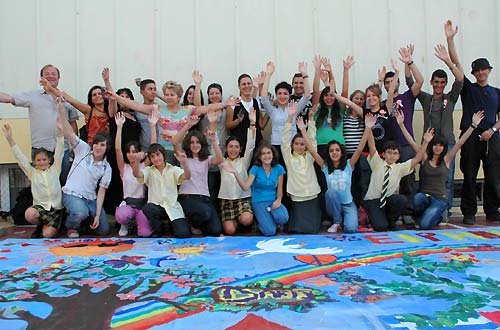
The entire group after completion
- The Kids' Guernica - Guernica Youth experiences - the ECCM Symposium "Productivity of Culture" and the Kids' Guernica exhibition in Athens 2007
ECCM Symposium „Productivity of Culture“ and Kids' Guernica Exhibition meant the discovery of a new form of dialogue between participants and children, 200 of which had come from the Athens 108 district school, while Dusan Sidanski discovered a dialogue neglected largely in Europe. He saw onhand of the mural from Nepal that it is important to further the dialogue between city and rural areas.
- Empathy and Imagination as prerequisite for dialogue
Some insights into the Kids' Guernica - Guernica Youth methodology has to do with bringing about such experiences coming close to wonder in the Ancient Greek philosophical sense e.g. Z. Herbert describing how he felt when seeing rocks gushing out of the Aegean sea that he was experiencing again "the birth of the earth."
For a world lacking dialogue, the reasons for this were already explained by Picasso. He said while children have this creative imagination, once adults they tend to lose it and therefore have no empathy to understand the other.
When children paint, their soul touches the canvas and sets free the imagination so that they can enter a dialogue with the other.
By painting together with the outcome of the whole always a surprise for everyone since not predetermined by anyone, lest by adults, they learn to creating conditions for empathy.
A key term for this process is called by academics "collaborative learning" while more appropriate would be children playing in the street to set their own rules as described by Piaget in how children develop already moral concepts when playing marbles.
7. Why is dialogue so difficult?
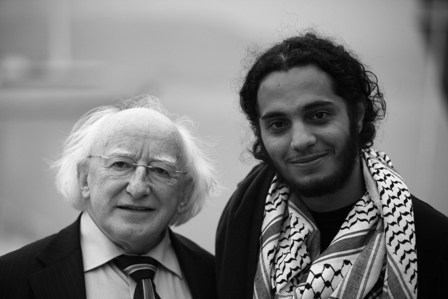
Michael D. Higgins and Jad Salman in Athens 2007 Photo by Kostas Kartelias
When Michael D. Higgins meet Jad Salman in 2007, he said immediately that „the Palestinian story is one of the most difficult ones to tell!“
In absence of narratives, culture can no longer be considered as being engaged in a search for truth according to Michael D. Higgins. Consequently he believes not only individuals, but entire population groups are "alienated", and therefore not at all engaged in poetic—philosophical dialogues. It can lead to a dangerous anti-politics stance and from there to a destruction of democracy which is based on dialogue.
Culture as mask - Dialectic of Securalization
The poet Brendan Kennelly said that we have "to learn to use culture, not abuse it", for too often it is used to mask the brutality of the state destroying the very basis of culture as outcome of dialogues. Little has been understood so far a special feature of the dialectic of securalization since it is mainly related to the state-church, politics-religion relationship, and yet if culture begins to emancipate itself from state tutelage, the state feels threatened, indeed 'terrorized' if without such a cultural mask so as to appear 'civilized'.
Interestingly enough
- Picasso saw mask as sign of fetish, but also as protection
- Adults mask often real motives out of fear of being misunderstood
- Children paint without fear while youth test honesty of the world
The sun needs sun glasses - towards an imaginative language

Light by itself can blind. No child is advised to look directly into the sun. But we do need light to see. This is one of the first paradoxes children have to learn to overcome and therefore limit their curiosity as to what would happen if they look directly into the sunlight. Going blind
i why do symbols say something in a world empty of meanings
ii. there is a need for special knowledge to overcome the split between material and spiritual world
iii. to overcome the split may be best done by forstering dialogues between cultures
8. Memory culture and the politics of memory in a globalised world
There is going to be offered a combination of workshops and conference by the University of Cologne for September 2015. It has the following introduction:
"It is.... necessary to differentiate between memory cultures, which are manifested in different forms and media, and the politics of history, which is understood as the support of public memories for political reasons and the goals of political agendas. At the same time, one must question how memories are passed on from one generation to the next, which has been intensely discussed since the turn of the century under the terms memory and post memory."
Source: http://lateinamerika.phil-fak.uni-koeln.de/22561.html
Related to this has to be the question about national narratives and official policies with regards to a 'memory culture' so predominant in countries like Israel and Germany. It is made explicit by the slogan "never to forget" the horrors of the Holocaust, but lately is made evident in Germany, for instance, how German re-unification is being treated by an exhibition called Alltag Einheit.
Kids' Guernica – Guernica Youth
represents another way of working with memory. For example, the last mural painted in Tripoli, Lebanon is called by those who created it together with Valia Maish: To remember we need to forget
The philosopher Bart Verschaffel characterised already in 2011 this memory work from below at the opening of a symposium about Kids' Guernica and European Capitals of Culture held in Gent as follows:
Bart Verschaffel, University of Gent
"Kids Guernica. Why is a symposium on such a specific project at its place within the University walls? I believe Kids Guernica is a good example, and a very interesting ‘case’, of what one could call ‘field work in memory studies’.
As we all know, modern people, modern societies, are not simply free from their past – as they might have hoped – on the contrary. The waning of tradition, the loss of continuity, does not make things more easy, and life more light, on the contrary – the past, that exists and survives in many forms, comes back as a ‘problem’ – ‘a problema’in the Greek sense of the word, referring to the dark answer the gods give to those who come to ask for advice, the dangerous riddle the gods throw at the feet of the humans, as an obstacle they have to make sense of.
Modern, western society has developed a neutral ‘scientific’ way to deal with its past: historical research, history writing. The narrative presuppositions and representation strategies, used in academic history writing, have been criticized in many ways during the last decades. This has resulted in trying out alternative ways – less cold, less neutral, less scientific – ways to investigate the past, by linking it to remembrance, by linking the desire to understand what has happened with some kind of involvement, with commitment. The commitment of the witness in certain cases, the commitment of what I would call ‘active listening to the past’ in other cases. That is how I understand what Kids' Guernica is about: what the youngsters and the children do while working on the paintings is becoming involved in a past they have not lived themselves, through active listening…
Memory studies have now become a new, fashionable trend in academic research. There is a danger, though, of academic recuperation – of academics distancing themselves from the task of ‘objective’ historical research and truth-finding, flirting with a warmer dealing with the past, without however being involved themselves. There is nothing wrong with academic conferences. But it is, as a counterbalance, equally smart to invite, within the university walls, field workers in memory work, personally engaged in specific projects."
At this exhibition in Olympia, Sept. 2 - 6 and then in the Cycladic Museum Sept. 6th in conjunction with the Symposium "The need for a constructive dialogue", the memory of what happens before, during and after the Olympic Games are held in a particular city, needs to be focused upon. Too often the fact that dialogue needs to be differentiated is ignored. The differentiation is only possible if there is work with memory possible. They allow the picking up of experiences made over time. It allows also the making of a cultural synthesis out of different viewpoints, ideas and practical judgements. With regards to making history and taking on identity, it is also considered important to step out of the system terminating in a non memorable form of apparent normality and into the memory track as Sigmund Freud called it. How important the leaving of traces is, that has also been emphasized by the work done by Alexandra Zanne with children suffering not only from epilepsy, but also from a lack of traces they can remember so that when they tell stories, they can develop their identities. Memory as intangible cultural heritage should not erased as much as tangible cultural heritages should not be destroyed since they give evidence to other forms of existence in the civilization of mankind. We are all poorer of if something thereof has vanished from the surface of the earth, and no dialogue takes place since replaced by a deadly silence.
Related to the theme of redemption work, memories of the war pose another problem. Not to forget and yet to forgive is obviously not easy for those who suffered under the violence, but then there are equally those who take advantage of this moral guilt and proceed to sharpen their moral judgements and even condemnations on the basis of what happened in the past. They do not forgive even though that would be the work of love as stated by the philosopher Krocina who instigated The letter of forgiveness on behalf of the Polish bishops who send the letter to the German bishops. The letter begins with the significant words: "forgive that we have to ask for forgiveness!"
Something similar applies to the German-Greek relationship still lacking in 2015 sufficient evidence that the reconciliation and redemption work has created a basis for an open relationship not to be distorted by mistrust and an unforgiven attitude. Some politicians have tried during the Greek crisis to instrumentalize it as if it was merely a matter of paying back what was stolen or what damages were created during the German occupation. Here Hagen Fleischer has said clearly much more worrying is the cultural occupation so that Greek delegations constantly adopt and accept the German criteria even for the term justice, and this to the disadvantage of a true reconciliation which goes hand in hand with the ability to stand up to oneself and being able to preserve one's own human dignity. Interestingly enough there took place a Kids' Guernica exhibition in Kalavrita, Greece in 2004, see http://www.kids-guernica.org/KGFiles/NS-Greece-E.html
9. The migrants of the 21st century - fleeing into horror images and the failure to understand the other
From Picasso's human cry to the childrens' wishes for peace: proheisis by Aristotles
Images upon images as layers of experience while learning to fill such a vast and empty space as that canvas
"Fluchtpunkte" - points to escape to
reflections of work with migrants by Anka Landtau
leads to the conclusion
"Do we really understand, just because we can carry ahead of us a historical image of horror? Our glances meet at the point to which we flee to, because we make ourselves an image. But what about the reality of the other? By means of parallel lines, our guidelines, our ways, our border lines."
This leads to two concluding observations for now:
- From Picasso's human cry to the childrens' wishes for peace: proheisis by Aristotles
- Images upon images as layers of experience while learning to fill such a vast and empty space as that canvas
While human pain is hardly ever made visible or becomes audible since expressed only in intimate spaces when no one else is around to listen and to observe, children are no strangers to philosophical thoughts. They do follow what Aristotles considers to be the prime form for articulating and for recognizing goals, namely "proheisis" or the 'imaged wish' which gives rise to theory and therefore knowledge on how to fulfil such a wish.
As far as the painting of these murals are concerned, by now many layers of new images have been projected upon Picasso's Guernica. They say something about the layers of experience, but also what are the raw materials of pain, fear, and wishes of children and youth in a world too much entangled in wars and civil strife as to be able to sustain the search for a 'permanent peace' the philosopher Kant had written about.
10. The structure of dialogue within Kids' Guernica - Guernica Youth
These peace murals stand for a special dialogue since they use the imagination to foster empathy for the other.
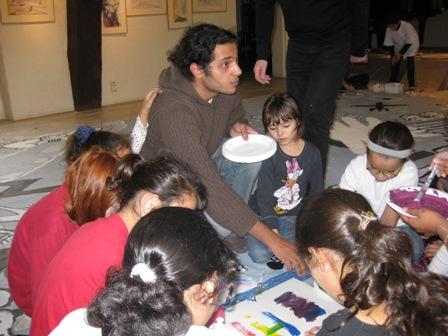
Jad Salman with children in Picasso's atelier in Paris 2009
Jad Salman, artist from Palestine, would say that this is made possible by children and youth who express themselves among many other things joy in such simple terms, that adults need to overcome the risk to overlook them because they appear simple and therefore not to understand the depth of their longing for peace.
Especially in a digital age, when other images dominate and literacy more often being lost than gained through the Internet, this understanding of peace as requiring the imagination so as to have empathy for the other, that is needed more than ever.
Hatto Fischer
Olympia 2.September 2015
« Press Release | Olympic Truce for Olympic Games Rio de Janeiro 2016 »

